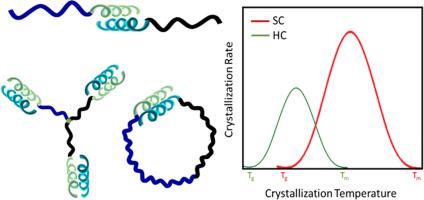Progress in Polymer Science ( IF 27.1 ) Pub Date : 2023-09-18 , DOI: 10.1016/j.progpolymsci.2023.101742 Rose Mary Michell , Viko Ladelta , Edgar Da Silva , Alejandro J Müller , Nikos Hadjichristidis

|
This review presents the state of the art of complex macromolecular architectures based on polylactide stereocomplexes (PLA-sc) from the viewpoint of synthesis and crystallization. First, we discuss the nomenclature, synthesis, epimerization, and lactide (LA) properties as a bio-derived cyclic dimeric monomer comprising two chiral carbons. Among several polymerization methods, catalytic ring-opening polymerization (ROP) is the most common and versatile technique to access stereoregular (isotactic) PLA, which is the prerequisite to preparing PLA-sc. Combined with other living and controlled/living polymerization techniques, ROP of LA has yielded various PLA-sc-based macromolecular architectures, including copolymers, stars, graft, cyclic, brush, and hybrid materials. New approaches to synthesizing monodisperse discrete oligoLA are also discussed. We show that a small change in the architectures, microstructures, molecular weight, or other chemical and physical modifications affects the behavior of PLA-sc. Moreover, the crystallization of PLA-sc, after more than 30 years of study, still presents many challenges. The crystalline morphology is also a subject of debate. Recent findings suggest a new crystalline unit cell for PLA-sc. Adding a third component or changing chain architecture can significantly modify the properties of the formed PLA-sc. The complex relationship between flexibility, nucleation, diffusion, and the interactions needed for the joint crystallization of the enantiomers constitutes a very large source of variables. As a result, PLA-based stereocomplex materials can be tailored by manipulating one or several of these variables.
中文翻译:

基于聚乳酸立体复合物的分子结构:合成和结晶
这篇综述从合成和结晶的角度介绍了基于聚丙交酯立体复合物(PLA-sc)的复杂大分子结构的最新技术。首先,我们讨论作为包含两个手性碳的生物衍生环状二聚单体的命名、合成、差向异构化和丙交酯 (LA) 特性。在多种聚合方法中,催化开环聚合(ROP)是获得立构(全同立构)PLA的最常见和通用的技术,这是制备PLA-sc的先决条件。与其他活性和受控/活性聚合技术相结合,洛杉矶的ROP已经产生了各种基于PLA-sc的高分子结构,包括共聚物、星形、接枝、环状、刷状和杂化材料。还讨论了合成单分散离散寡聚LA的新方法。我们表明,结构、微观结构、分子量或其他化学和物理修饰的微小变化都会影响 PLA-sc 的行为。而且,PLA-sc的结晶经过30多年的研究,仍然面临着许多挑战。晶体形态也是一个争论的话题。最近的研究结果表明了一种新的 PLA-sc 晶体单元。添加第三个组分或改变链结构可以显着改变所形成的 PLA-sc 的性能。柔性、成核、扩散和对映体联合结晶所需的相互作用之间的复杂关系构成了一个非常大的变量来源。因此,可以通过操纵这些变量中的一个或多个来定制基于 PLA 的立体复合材料。































 京公网安备 11010802027423号
京公网安备 11010802027423号